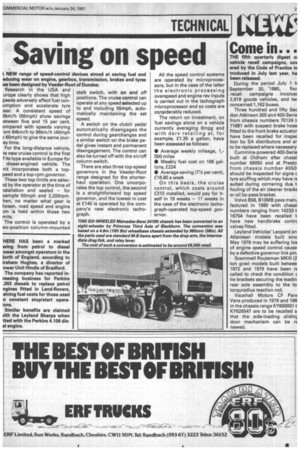Saving on speed
Page 23

If you've noticed an error in this article please click here to report it so we can fix it.
NEW range of speed-control devices aimed at saving fuel and educing wear on engine, gearbox, transmission, brakes and tyres tas been designed by Veeder-Root of Dundee.
Research in the USA and urope clearly shows that high peeds adversely affect fuel conumption and accelerate tyre rear. A consistent speed of Okm/h (50mph) show savings etween five and 15 per cent, ompared with speeds varying .om 64km/h to 96km/h (40mph D 60mph) to give the same jourey time.
For the long-distance vehicle, le new cruise control is the first f its type available in Europe for diesel-engined vehicle. The nit incorporates both a toppeed and a top-rpm governor. These two top limits are selec3cl by the operator at the time of Istallation and sealed — for xample 55mph and 2,200rpm. hen, no matter what gear is hosen, road speed and engine Pm is held within those two mils.
The control is operated by a wo-position column-mounted stalk switch, with on and off positions. The cruise control can operate at any speed selected up to and including 55mph, automatically maintaining the set speed.
A switch on the clutch pedal automatically disengages the control during gearchanges and a similar switch on the brake pedal gives instant and permanent disengagement. The control can also be turned off with the on/off column switch.
There are also three top-speed governors in the Veeder-Root range designed for the shorterhaul operation. One uncorporates the top control, the second is a straightforward top speed governor, and the lowest in cost at £140 is operated by the company's new electronic tachograph. All the speed control systems are operated by microprocessors, but in the case of the latter the electronic processing overspeed and engine rev inputs is carried out in the tachograph microprocessor and so costs are considerably reduced.
The return on investment, on fuel savings alone on a vehicle currently averaging 6mpg and with dery retailing at, for example, £1.35 a gallon, have been assessed as follows: • Average weekly mileage, 1,000 miles • Weekly fuel cost on 166 gallons, £224 • Average saving (71/2 per cent), £16.80 a week On this basis,the cruise control, which costs around £310 installed, would pay for itself in 19 weeks — 11 weeks in the case of the electronic tachograph-operated top-speed governor.








































































































